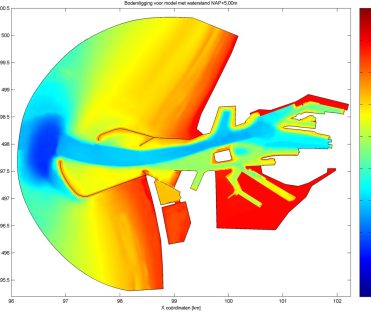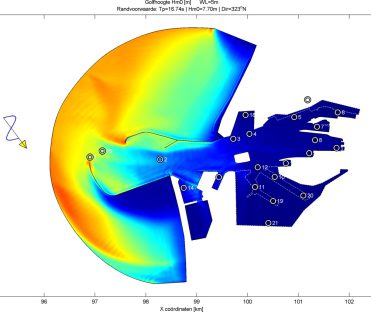Wave conditions IJmuiden harbour
DOWNLOAD PROJECT SHEET
Demonstrate that HARES can be applied within the HB-Havens software

Dutch Ministry of Infrastructure and Water Management (Rijkswaterstaat)

IJmuiden, the Netherlands

2018 - 2019
Application HARES within HB-Havens software
To determine the wave conditions (hydraulic boundary conditions) of the Dutch primary water defences inside harbours Rijkswaterstaat has developed the software package HB-Havens. A local wind wave growth model (SWAN) and a numerical wave penetration model is used in this package. Because the presently used wave penetration model interferes the efficient use of HB-Havens, Rijkswaterstaat asked Svašek Hydraulics to implement Svašek’s own wave penetration model HARES.
At a location just offshore IJmuiden harbour the wave conditions are available for 540 different combinations of wind direction, wind speed and water level. These wave conditions are translated to various output locations inside the harbour using SWAN and HARES within the method of HB-Havens.
With increasing water levels the transmission over the breakwaters increases and more and more quay areas are flooded. Therefore, in HARES each modelled water level has a dedicated computational mesh with 4 to 5 million elements. The grid size depends on the water depth so that there are at least 16 elements per wavelength at each location.
Each wave condition is discretised by splitting the wave spectrum into 15 frequencies and 17 directions. HARES has a very fast and efficient spectral treatment of bottom friction and wave breaking that is based on the entire wave spectrum and not only on the individual components. All spectral components are computed within one HARES computation and after each iteration step the entire wave spectrum is composed to calculate the amount of bottom friction and wave breaking. This way it is prevented that too much energy enters the harbour.
With this study, Svašek Hydraulics has shown that HARES is an accurate and detailed tool to determine the wave penetration in harbours that fully fit within the RWS system used by HB-Havens.
The limitations of existing wave penetration models, like limited number of grid cells, long computational time, difficulty in incorporating flooded quay areas and low crested breakwaters and underestimation of wave energy dissipation due to wave breaking and bottom friction are eliminated.
© Aerial photo Beeldbank RWS.
Bernard Eikema
Project leader

More information about Svašek or our expertises?
Please contact us or make an appointment.
CONTACT US





